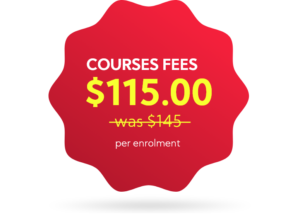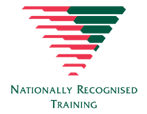 4.5hrs
4.5hrs+5.5 hours online
precourse learning
![]()
About this course
This course contains the skills and knowledge required to provide a first aid response to infants, children and adults, with special consideration given to asthma and anaphylaxis emergencies and managing children who are involved in and those who are witness to incidents of illness or injury.
This course is approved by Australian Child Education and Care Quality Authority (ACECQA) and meets the requirements of First Aid (including CPR), Asthma and Anaphylaxis emergency training for educators and carers working in schools and child care centres.
This course covers the following units of competency:
- HLTAID009 – Provide cardiopulmonary resuscitation (supersedes HLTAID001 Provide cardiopulmonary resuscitation)
- HLTAID010 Provide basic emergency life support (supersedes HLTAID002 Provide basic emergency life support)
- HLTAID011 – Provide First Aid (includes CPR) (supersedes HLTAID003 Provide first aid)
- HLTAID012 – Provide First Aid in an education and care setting
Why child education professionals need to learn CPR
Child Education CPR training is extremely important. Child education is a profession that involves a huge amount of responsibility and often involves the care of multiple children at one time. As active children are prone to accidents, every child education professional should be fully prepared for this to happen. Children are the most vulnerable people in our society and as their caretaker, learning CPR is one of the best ways to ensure you are prepared if they ever fall ill or have a serious accident.
Studies show that when the brain receives no oxygen for four minutes, brain tissue begins to die and even after being resuscitated, the damage will be permanent. That is why it’s so essential that paramedics attend the scene of an accident or illness immediately, and also why it’s important that childcare professionals know what to do while waiting for paramedics to arrive.
With our child education CPR course in Brisbane, you can learn the fundamentals of resuscitating a child in a way that doesn’t cause further harm. You can ensure children in your care have the very best chance of survival.
A different kind of CPR
While much of the basics remain the same, Child CPR is very different to regular CPR in that it takes into consideration the smaller stature. Furthermore, CPR training for young children focuses largely on cardiopulmonary resuscitation as a result of children being more vulnerable to choking. This is one of the most common reasons why CPR is required, but our child education CPR training also offers learning and training for cases of drowning, and other situation where CPR maybe required.
The team at Fluid First Aid will walk you through the most common illnesses and injuries that children of different ages face, and the best practices to ensure that a child is kept safe while medical professionals travel to the scene. With our online video courses and hands-on workshops, you’ll learn the skills you need to save children’s’ lives.
Save time and money!
You’ll save time and money by learning online. Our online video courses have received rave reviews and even an award! We have created a course that is easy to follow and that can be accessed and used by individuals or large groups. Follow our series of online talks and workshops before meeting our experts in a hands-on experience to perfect your skills and become a qualified education and child care first aider.
There’s no written test on the day of the hands-on workshop. Once you’re ready and have compently completed the course, you’ll be issued with a nationally recognised certificate with a swift turnaround time.
You control your schedule, you learn at your own pace, and you also benefit from our highly competitive prices. With all this in mind, it’s no wonder businesses all over Brisbane (and beyond!) turn to us for our expertise. We deliver the results you need with a schedule that works around you and a price you can afford.
![]()
Course Content
Our education and childcare first aid course includes the most up-to-date basic life support principles including:
- CPR and defibrillation for adults, children and infants
- Differences between adults and children for first aid
- Breathing emergencies including cover Asthma and Anaphylaxis or severe allergic reaction and choking
- Fractures, Dislocations, Sprains and Strains
- Head, Neck and Spinal Injuries
- Burns
- Diabetes
- Temperature induced illness
- Bites and stings
- Poisoning and toxic substances
- Seizures, Convulsions
- Legal issues surrounding first aid in the education and care setting
- Infection control & reporting
- Non-life-threatening and life-threatening bleeding
- Dehydration
- Eye injuries
- Fever
- Hypothermia and hyperthermia
- Minor wounds and nose bleeds
- Pain
- Shock
- Vomiting and diarrhoea
- Identification and management of a sick infant or child including:
- General signs and symptoms of acute illness in children and infants
- Referral and advice services including recognition of signs or symptoms requiring immediate ambulance response
- Emergency action plans for known medical conditions including Asthma and Anaphylaxis
- Age appropriate communication and distraction techniques
- First aider response to basic physiological differences in children
![]()
Course Components
- Online learning and assessment (up to 5.5 hours to complete)
The online video learning component allows you the time and space to learn and complete theory assessment at your own pace, when and wherever you want! Actual duration of this component will vary depending on your past experience and knowledge.
You will need access to a computer and the internet to complete this part of your course. If this is difficult for you we can arrange access for you – just give us a call!
You must have successfully completed the online assessment prior to attending the practical face to face component of the course. - Face-to-face practical session (4.5 hours duration)
This face-to-face practical session gives you the opportunity to learn the applied skills, practice them and receive trainer feedback and then complete assessment tasks.
![]()
Course Requirements
To successfully complete this course, you must:
- 14 to 17 years learners must email or bring signed under 18 years consent form
- Have Literacy skills to read and interpret statutory signage, warning signs and instructions regarding the use of first aid and CPR materials such as face shields, and Automated External Defibrillators.
- Have the ability to complete a workplace Incident Report.
- Have numeracy skills to perform simple calculations with regard to the rate of chest compressions and rescue breathing.
- Have a level of oral communication that enables them to make accurate verbal reports to emergency response services and workplace supervisors.
- the physical ability to meet the following evidence requirements:
- Perform at least 2 minutes of uninterrupted single rescuer cardiopulmonary resuscitation (CPR) (5 cycles of both compressions and breaths) on an adult resuscitation manikin placed on the floor
- Perform at least 2 minutes of uninterrupted single rescuer CPR (5 cycles both compressions and breaths) on a child resuscitation manikin placed on the floor
- Perform at least 2 minutes of uninterrupted single rescuer CPR (5 cycles both compressions and breaths) on an infant resuscitation manikin placed on a firm surface
You also have to be able to complete the online learning and assessment section of the course. However, if you do not have access to or lack confidence in using a computer and/or the internet you can contact our office and make arrangements for the access and support you require.
Participants under the age of 18 are required to provide a consent form completed by their legal guardian.
If you are concerned about any of the above requirements, please contact us to discuss your concerns and find out what support options are available.
![]()
Assesments
You will be required to complete three types of assessments for this course:
- Online interactive theory assessment
- Online Report
- Demonstration of practical skills (classroom-based)
Download the Guide Learners Practical Assessment Guide
Any queries about your assessment result it is best to first speak to your assessor to arrange a reassessment. If you are still unhappy with the process we have an Appeals Procedure for you to follow, details can be found in our Learner Handbook / Complaints and Appeals.
![]()
Certificates
On successful completion of the training and assessment activities, we will issue a Nationally Recognised Statement of Attainment (certificate) for the following unit:
- HLTAID012 Provide First Aid in an education and care setting
- HLTAID011 Provide First Aid
- HLTAID010 Provide basic emergency life support
- HLTAID009 Provide Cardiopulmonary Resuscitation
This Statement of Attainment will be emailed in electronic PDF format to your nominated email address within two business days of successful completion of all course components, providing all online and practical competencies are met.
![]()
Learner Support
If you have any special learning or physical needs please contact us prior to attending your course and we can discuss suitable support options. This includes Language, Literacy or Numeracy (LLN) needs or difficulties accessing a computer and/or the internet to complete the online learning and assessment.
If you are concerned that your language, literacy or numeracy skills will not be sufficient to complete the course, you can complete our online interactive LLN assessment. You will be required to log-in and create a Learner account. We will get back to you with the results and discuss any required support we can provide or refer you to other suitable support agencies.
The LLN tool can be found HERE
Please note: you must have the physical ability to complete the application of CPR as stated in the Course Requirements.
Training Done Differently
Save Time, Have Fun and Leave Confident
ENROLLING IN THE COURSE
- To enrol in the course online, please book your practical workshop HERE
- To enrol over the phone, please call: 1300 976 276
- Business Hours: 8:30am-5:00pm Mon-Fri

* All fees must be paid prior
to course commencement.
This unit is nationally recognised. Upon successful completion, learners will receive a Statement of Attainment issued by:
HLTAID012 – Provide First Aid in an education and care setting
Fluid First Aid – RTO Code 45508

This unit is nationally recognised. Upon successful completion, learners will receive a Statement of Attainment issued by:
Fluid First Aid – RTO Code 45508


We will make refunds to Learners in certain circumstances as listed in the table. To apply for a refund you should email a request to: admin@fluidlearning.com.au
Public Individual Course Booking
Private Corporate Group Booking

Does this course include CPR?
Yes.
Can I do this course without CPR?
No. CPR training and assessment is a compulsory component of the HLTAID012 unit of competency.
Where can I find more information about this unit?
Full information regarding the contents of the unit can be found on training.gov.au
When does my certificate expire?
The Australian Resuscitation Council (ARC) and workplaces codes of practice recommend CPR training should be updated every year.
As an added service, we will send you an email and SMS reminders 45 days before units are due to be updated.
Why Learn The Fluid Way



 $115.00
$115.00  Locations
Locations Schedule
Schedule

 Save time
Save time Have fun
Have fun Leave confident
Leave confident